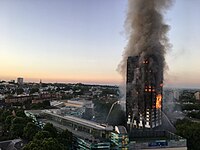
Photo from wikipedia
Abstract An investigation was carried out to examine the structural response of two steel-concrete composite floor system under traveling fires. The thermal-mechanical analyses were performed using the finite element software… Click to show full abstract
Abstract An investigation was carried out to examine the structural response of two steel-concrete composite floor system under traveling fires. The thermal-mechanical analyses were performed using the finite element software ABAQUS, where the traveling fire exposures were defined using the improved Traveling Fires Methodology. Essential factors influencing the fire resistance of the composite floor systems, namely the fire rating and fire protection scheme of the passive fire protection were varied in this study. The composite floor systems were also exposed to an ASTM E119 standard fire and two natural fire exposures applied to a corner compartment. The results showed that fire insulations derived from prescriptive approaches may not provide adequate safety under traveling fires. Through a performance-based design procedure, improved performance under traveling fires was achieved through better allocation of the fire protection. Specifically, insulation from the interior floor beams were removed and applied to the girders and exterior floor beams. This fire safety solution is economical when compared to the simultaneous increase of fire protection of all floor beams and girders, typical of a prescriptive design approach.
Journal Title: Journal of Constructional Steel Research
Year Published: 2021
Link to full text (if available)
Share on Social Media: Sign Up to like & get
recommendations!